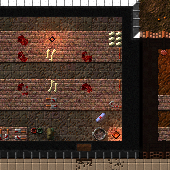Degrade: Difference between revisions
No edit summary |
No edit summary |
||
| Line 1: | Line 1: | ||
[[File:degrade_preview.png|thumb|right|A [[cannibal]] building suffering 33% decay.]]'''Degrade''' is how much a [[building]] or [[road]] has decayed - how much wear and tear the building has suffered. To rectify this, a [[settlement]] must have one or more [[janitor]] buildings. Janitors will be responsible for constantly doing repairs and maintaining the integrity and foundation of constructs by keeping their degradation percentage at 0%. Things will start containing penalties if there is too much degradation. Having a high [[isolation]] percentage can also ward off degradation. | [[File:degrade_preview.png|thumb|right|A [[cannibal]] building suffering 33% decay.]]'''Degrade''' is how much a [[building]] or [[road]] has decayed - how much wear and tear the building has suffered. To rectify this, a [[settlement]] must have one or more [[janitor]] buildings. Janitors will be responsible for constantly doing repairs and maintaining the integrity and foundation of constructs by keeping their degradation percentage at 0%. Things will start containing penalties if there is too much degradation. Having a high [[isolation]] percentage can also ward off degradation. | ||
There is another factor of constructs known as "[[rate]]". The higher the rate percentage, the faster something will degrade. Rooms will start taking on a decayed and almost abandoned appearance as degradation increases. Janitors will need [[resources]] matching the type of building to conduct maintenance and repairs. For example, janitors will need [[fabric]] to maintain a carpet inside a [[ | There is another factor of constructs known as "[[rate]]". The higher the rate percentage, the faster something will degrade. Rooms will start taking on a decayed and almost abandoned appearance as degradation increases. Janitors will need [[resources]] matching the type of building to conduct maintenance and repairs. For example, janitors will need [[fabric]] to maintain a carpet inside a [[flat house]], or [[stone]] to maintain a stone building. | ||
Degradation rates can be slowed by purchasing construction technique upgrades with [[knowledge]] points. | |||
==In-game description== | ==In-game description== | ||
''"Degrade affects rooms negatively. Janitors and [[odd jobber|idle people]] will maintain rooms. Some maintenance requires materials."'' | ''"Degrade affects rooms negatively. Janitors and [[odd jobber|idle people]] will maintain rooms. Some maintenance requires materials."'' | ||
[[Category:Gameplay elements]] | [[Category:Gameplay elements]] | ||
Revision as of 13:26, 26 August 2021

Degrade is how much a building or road has decayed - how much wear and tear the building has suffered. To rectify this, a settlement must have one or more janitor buildings. Janitors will be responsible for constantly doing repairs and maintaining the integrity and foundation of constructs by keeping their degradation percentage at 0%. Things will start containing penalties if there is too much degradation. Having a high isolation percentage can also ward off degradation.
There is another factor of constructs known as "rate". The higher the rate percentage, the faster something will degrade. Rooms will start taking on a decayed and almost abandoned appearance as degradation increases. Janitors will need resources matching the type of building to conduct maintenance and repairs. For example, janitors will need fabric to maintain a carpet inside a flat house, or stone to maintain a stone building.
Degradation rates can be slowed by purchasing construction technique upgrades with knowledge points.
In-game description
"Degrade affects rooms negatively. Janitors and idle people will maintain rooms. Some maintenance requires materials."